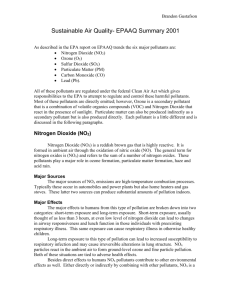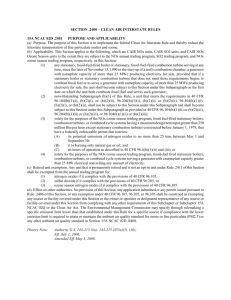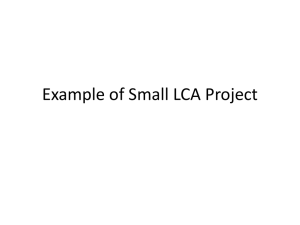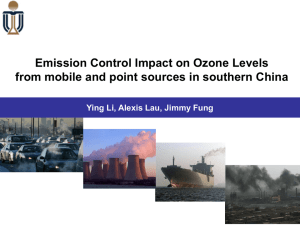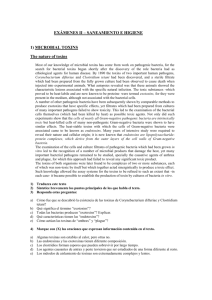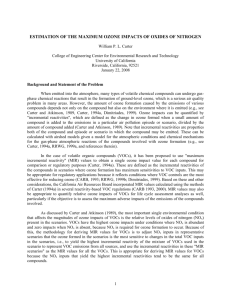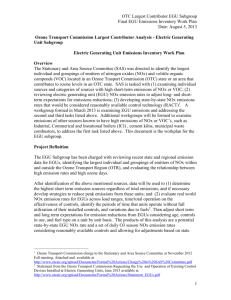Nitrogen Oxides (NOx)
advertisement
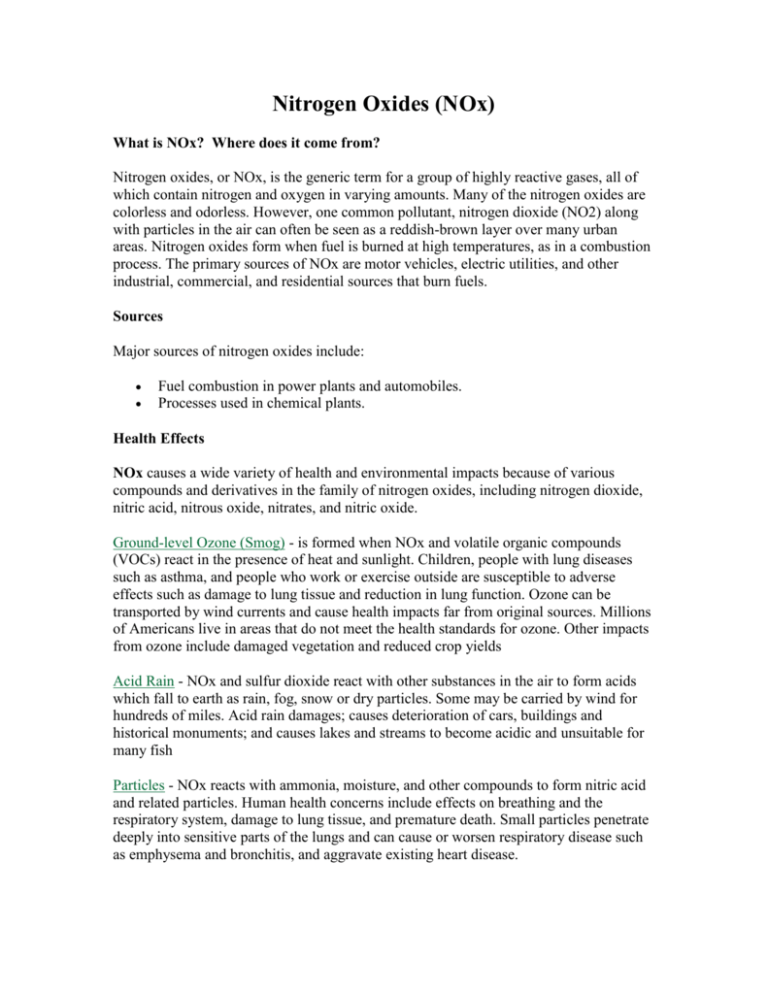
Nitrogen Oxides (NOx) What is NOx? Where does it come from? Nitrogen oxides, or NOx, is the generic term for a group of highly reactive gases, all of which contain nitrogen and oxygen in varying amounts. Many of the nitrogen oxides are colorless and odorless. However, one common pollutant, nitrogen dioxide (NO2) along with particles in the air can often be seen as a reddish-brown layer over many urban areas. Nitrogen oxides form when fuel is burned at high temperatures, as in a combustion process. The primary sources of NOx are motor vehicles, electric utilities, and other industrial, commercial, and residential sources that burn fuels. Sources Major sources of nitrogen oxides include: Fuel combustion in power plants and automobiles. Processes used in chemical plants. Health Effects NOx causes a wide variety of health and environmental impacts because of various compounds and derivatives in the family of nitrogen oxides, including nitrogen dioxide, nitric acid, nitrous oxide, nitrates, and nitric oxide. Ground-level Ozone (Smog) - is formed when NOx and volatile organic compounds (VOCs) react in the presence of heat and sunlight. Children, people with lung diseases such as asthma, and people who work or exercise outside are susceptible to adverse effects such as damage to lung tissue and reduction in lung function. Ozone can be transported by wind currents and cause health impacts far from original sources. Millions of Americans live in areas that do not meet the health standards for ozone. Other impacts from ozone include damaged vegetation and reduced crop yields Acid Rain - NOx and sulfur dioxide react with other substances in the air to form acids which fall to earth as rain, fog, snow or dry particles. Some may be carried by wind for hundreds of miles. Acid rain damages; causes deterioration of cars, buildings and historical monuments; and causes lakes and streams to become acidic and unsuitable for many fish Particles - NOx reacts with ammonia, moisture, and other compounds to form nitric acid and related particles. Human health concerns include effects on breathing and the respiratory system, damage to lung tissue, and premature death. Small particles penetrate deeply into sensitive parts of the lungs and can cause or worsen respiratory disease such as emphysema and bronchitis, and aggravate existing heart disease. Water Quality Deterioration - Increased nitrogen loading in water bodies, particularly coastal estuaries, upsets the chemical balance of nutrients used by aquatic plants and animals. Additional nitrogen accelerates "eutrophication," which leads to oxygen depletion and reduces fish and shellfish populations. NOx emissions in the air are one of the largest sources of nitrogen pollution in the Chesapeake Bay. Global Warming - One member of the NOx, nitrous oxide, is a greenhouse gas. It accumulates in the atmosphere with other greenhouse gasses causing a gradual rise in the earth's temperature. This will lead to increased risks to human health, a rise in the sea level, and other adverse changes to plant and animal habitat. Toxic Chemicals - In the air, NOx reacts readily with common organic chemicals and even ozone, to form a wide variety of toxic products, some of which may cause biological mutations. Examples of these chemicals include the nitrate radical, nitroarenes, and nitrosamines. Visibility Impairment - Nitrate particles and nitrogen dioxide can block the transmission of light, reducing visibility in urban areas and on a regional scale in our national parks. Other Effects Oxides of nitrogen also can: Seriously injure vegetation at certain concentrations. Effects include: Bleaching or killing plant tissue. Causing leaves to fall. Reducing growth rate. Deteriorate fabrics and fade dyes. Corrode metals (due to nitrate salts formed from nitrogen oxides). Reduce visibility. Oxides of nitrogen, in the presence of sunlight, can also react with hydrocarbons, forming photochemical oxidants. Also, NOx is a precursor to acidic precipitation, which may affect both terrestrial and aquatic ecosystems. Chief Causes of concern: Nitrogen dioxide is one of the main ingredients involved in the formation of ground-level ozone, which can trigger serious respiratory problems. reacts to form nitrate particles, acid aerosols, as well as NO2, which also cause respiratory problems. contributes to formation of acid rain. contributes to nutrient overload that deteriorates water quality. contributes to atmospheric particles, that cause visibility impairment most noticeable in national parks. reacts to form toxic chemicals. contributes to global warming. NOx and the pollutants formed from NOx can be transported over long distances, following the pattern of prevailing winds in the U.S. This means that problems associated with NOx are not confined to areas where NOx are emitted. Therefore, controlling NOx is often most effective if done from a regional perspective, rather than focusing on sources in one local area. NOx emissions are increasing: Since 1970, EPA has tracked emissions of the six principal air pollutants - carbon monoxide, lead, nitrogen oxides, particulate matter, sulfur dioxide, and volatile organic compounds. Emissions of all of these pollutants have decreased significantly except for NOx, which has increased approximately 10 percent over this period. The U.S. Environmental Protection Agency (EPA), states, and local governments work as partners to reduce emissions of NOx. Reducing emissions of NOx is a crucial component of EPA's strategy for cleaner air. EPA's Efforts to Reduce NOx Emissions standards for motor vehicles Since the 1970's, EPA has required motor vehicle manufacturers to reduce NOx emissions from cars and trucks. Reductions achieved through auto emissions control are significant. In the last ten years, NOx emissions from highway vehicles decreased by more than 5 percent, while vehicle miles traveled increased significantly. In a related effort, the use of reformulated gasoline has resulted in cleaner-burning engines. EPA and states continue to examine vehicle emissionstesting programs to ensure that readings accurately reflect emissions levels. Emission standards for electric utilities To help reduce acid rain, EPA devised a two-phased strategy to cut NOx emissions from coal-fired power plants. The first phase, finalized in a rulemaking in 1995, aimed to reduce NOx emissions by over 400,000 tons per year between 1996 and 1999. The goal of the second phase is to reduce emissions by over 2 million tons per year beginning in the year 2000. NOx Transport rule for 22 States The Clean Air Act requires states to reduce ground-level ozone. Since NOx and ozone can be transported long distances, the Act also requires "upwind" states to implement programs that will help "downwind" states meet the ozone standards. EPA issued a rule in 1998 that requires 22 states and the District of Columbia to revise their Implementation Plans to further reduce NOx emissions by taking advantage of newer, cleaner control strategies. The rule does not mandate how the reductions are to be achieved, but gives each affected state a NOx emission target. States have flexibility in determining how to reduce emissions. The goal of this rule is to reduce total emissions of NOx by 1.2 million tons in the affected states by 2007. This factsheet has been adapted from U.S. EPA Last updated September 2002


